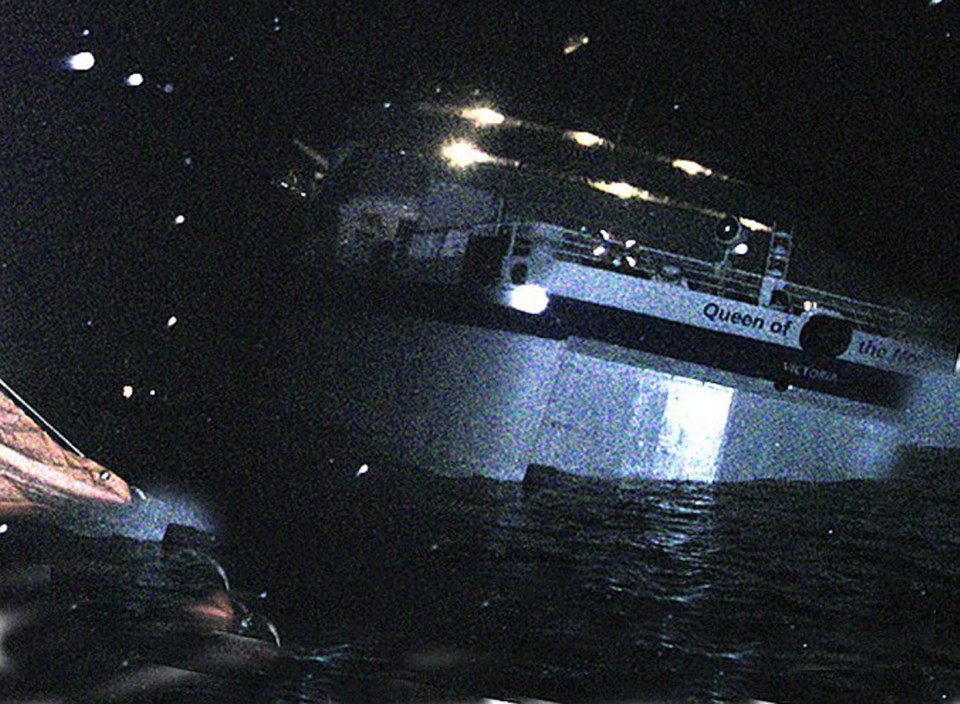 Ten years to the day after the sinking of the Queen of the North, Cameron Hill still won’t harvest the clam bed his grandfather taught him to dig as a boy.
Ten years to the day after the sinking of the Queen of the North, Cameron Hill still won’t harvest the clam bed his grandfather taught him to dig as a boy.
“It’s one of the most fruitful clam beds on the entire coast,” he says. But no, he’s not touching it, not with contaminants still burping up from the B.C. Ferries vessel, which sits upright and intact 1,400 feet below the surface of Wright Sound.
Others among the 150 or so residents of nearby Hartley Bay are similarly reluctant to gather shellfish or seaweed from beaches near the site. “Not much is being harvested in and around these areas at all,” says Hill, the principal of the village’s school and a member of the Gitga’at band’s elected council.
If 99 per cent of us had never heard of the tiny, isolated community before the Queen of the North sank, the reverse was true the next day. The Heroes of Hartley Bay — the 22 men who jumped into their boats and raced 16 kilometres to the scene in the dead of night — were celebrated across Canada. For awhile.
“Hartley Bay, 10 years after the fact, feels a little left alone,” Hill says. No one is sure how much, if any, fuel is trapped in the sunken ferry. No one is sure about the traditional food sources that make up much of the local diet.
Still, Hill says that when he thinks back to that night, his first thoughts are of the family of the two people who died.
It was at 12:20 a.m., March 22, 2006, that the ferry hit the rocks off Gil Island while sailing from Prince Rupert to Port Hardy.
At first it was thought that all 101 people on board — 59 passengers and 42 crew — had escaped on liferafts, but it soon emerged that a 100 Mile House couple, Gerald Foisy and Shirley Rosette, were missing.
Investigations showed the ferry had failed to make a slight course correction while exiting Grenville Channel. Blame fell on navigator Karl Lilgert, who in 2013 was convicted of criminal negligence causing death. The Crown argued Lilgert missed the routine turn because he was distracted by his ex-lover, the quartermaster with whom he was alone on the bridge for the first time since their relationship ended. Both denied that had anything to do with the sinking, and Lilgert maintained he had changed course.
Lilgert, sentenced to four years in prison, will be eligible for full parole April 15. The quartermaster was fired, as were the ship’s captain and second officer.
The tragedy was a factor in changes at B.C. Ferries. In 2007, Mike Corrigan, who was just nine days into his job as the corporation’s chief operating officer when the Queen of the North sank, shepherded through the SailSafe program — one that gives all employees ownership of safety issues — in co-operation with the ferry workers’ union.
B.C. Ferries now has a rule that two of each watch’s three navigation officers, plus the quartermaster, must be on the bridge at all times, and that the most senior officer must take the night watch. Simulators have been added for training purposes, all ships now have voyage data recorders and the movements of all vessels are monitored 24/7 from a high-tech communications centre.
Lawsuits following the sinking saw Foisy’s two daughters accept a $200,000 settlement, while Rosette’s family received an undisclosed amount. A class action suit on behalf of surviving passengers resulted in a $340,000 payout, but most of that went to legal fees, according to the Canadian Press.
What still stands out from 2006 are dramatic accounts from witnesses who described the sight of the ferry, lights ablaze, tilting wildly in the darkness, and the metal-on-metal sound of cars and trucks crashing into each other as the stern went under.
A year later, everyone in Hartley Bay could still tell you where they were that night. Septuagenarian Isobel Eaton was watching CSI (“I won’t go to bed until it’s over”) when she heard the radioed mayday at 12:25 a.m. She called a neighbour, then began making fish sandwiches for the passengers.
Marven Robinson didn’t remember hearing the distress call on the VHF radio but must have done so, because all of a sudden he was awake and scrambling out of his bedcovers. “There’s something wrong,” he told his wife. He called the Prince Rupert coast guard station, called some other Hartley Bay boys, then raced for the door — before realizing he was wearing nothing but boxers. “I said, ‘Aw …, I got to get dressed.’ ” He did so, hopped on his all-terrain vehicle, headed for the dock.
Artist Donald Reece was still up painting when the call came in. He dropped everything and made for the boats, abandoning the picture of a butterfly on which he was working. “I still haven’t finished it,” he said in 2007.
The 22 rescuers headed out in two gillnetters and a handful of smaller boats, including Bruce Reece’s 21-foot cabin cruiser. Heading back to the village with some of the survivors, he noticed a soaking wet little girl huddled by the boat’s propane heater, trying to warm her bare, frozen feet. Seeing her shivering, Reece peeled off his boots and gave her his socks.
Back at Hartley Bay, everyone was rustling up food and dry clothes for the survivors. Pint-sized Shelby Robinson, then 13, brought sandwiches and fruit to the cultural centre, as well as some running shoes and a couple of sweaters that she never saw again.
Bruce Reece’s wife, Betsy, brought clothes, too. In fact, she emptied Bruce’s sock drawer. Once all was said and done and the passengers had been evacuated to Prince Rupert, 140 kilometres away, Bruce Reece was left without a sock to his name. That’s an easy fix in Victoria, but not in a place as remote as Hartley Bay, where ATVs take the place of cars, boardwalks take the place of streets and, no, there isn’t a Walmart.
Hartley Bay is as isolated as it gets. There are no roads to the outside world, which can be reached only by air or water. When somebody is in trouble, it’s not as though you can call 911. On the central coast, it goes without question that you just hop in your boat and go help, which is what happened 10 years ago today.
“If it were to happen again — God forbid — the people of Hartley Bay would do exactly the same thing again,” Hill says.



